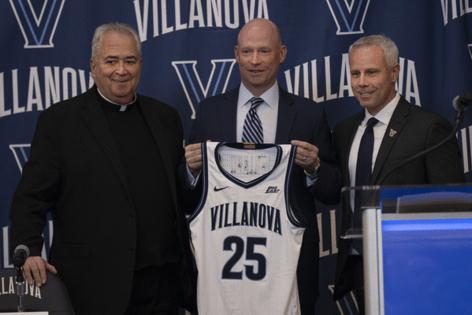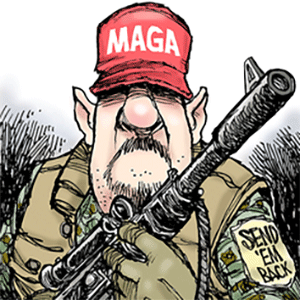Mike Sielski: Villanova, Temple and the Big 5 have to answer one core question to thrive in modern college hoops
Published in Basketball
PHILADELPHIA — Kevin Willard’s official introduction as Villanova’s men’s basketball coach had ended Wednesday, the administrators and boosters and former players dispersing, and in a quieter area inside the Finneran Pavilion, Eric Roedl started juggling. Ideas, not rubber balls or chain saws.
There is Villanova: the big-time Big East hoops program. There is Villanova: the elite academic institution with an estimated annual freshman cost north of $89,000. There is Villanova: the Catholic, Augustinian university, a keeper of the flames of Veritas, Unitas and Caritas — of Truth and Unity and Love. Each is regarded as a vital aspect of Villanova’s identity. But there always are choices. If you start flipping those factors in the air, from one hand to the other, which is the one the university can least afford to fall to the floor?
“We always need to maintain a strong connection between how we’re operating in athletics and making sure there’s a clear, strong alignment with the institutional values, with the academic mission,” said Roedl, Villanova’s vice president and director of athletics. “Villanova is unique because it’s an Augustinian institution. We want our coaches and our student-athletes to understand what kind of community this is. Having said that, we’re going out and trying to recruit the best, most talented student-athletes and staff we can. We’ve got to find a way to mesh all that together.”
This is the core challenge for any college or university that aspires to compete in Division I basketball — to really compete — in the age of name, image and likeness and pay-for-play, and, eventually, contracts for athletes. Every institution has to ask itself: What is our identity, and where does basketball factor into that identity? By firing Kyle Neptune and hiring Willard, who spent 12 years as a Big East head coach at Seton Hall and another three in the Big Ten at Maryland, Villanova’s decision-makers are leaving no doubt about where they come down on those questions.
They perceive men’s basketball as one of the university’s primary revenue-drivers, if not the primary one — a magnet for students, alumni and donors, a catalyst for loyalty and enthusiasm — and they largely are right in that perception. Just stand at the intersection of Lancaster and Ithan Avenues and take a gander: the renovated Pavilion, the expanded academic and administrative buildings and centers of student life, the new multideck parking garages.
The 10-year “master plan” that Villanova launched last year likely wouldn’t have been possible without Jay Wright, without Ryan Arcidiacono to Kris Jenkins at the buzzer, without Jalen Brunson and Mikal Bridges and Donte DiVincenzo and Collin Gillespie and Jermaine Samuels.
The other schools in the Big 5 either don’t have so clear a path or haven’t chosen to follow one. Temple’s misbegotten pursuit of football revenue led it out of the Atlantic 10 — where it defined itself as a basketball school, where it had natural rivalries and attractiveness — and into the American Athletic Conference.
Over their 12 years in the AAC, the Owls have six winning seasons, have qualified for the NCAA Tournament twice, and haven’t won a game in the tournament. What do you know? Turns out that when you’re a Philadelphia program, it’s more difficult to persuade recruits to play against North Texas, Tulane and Rice than against St. Joseph’s, La Salle, UMass and VCU.
St. Joe’s might be able to keep itself near the top of the A-10 and La Salle might be relevant in the conference for a change if their alumni bases and boosters can keep filling the coffers. If nothing else, St. Joe’s has an advantage in that basketball is an intrinsic aspect of its campus culture. The Hawk will never die. It’s in the air there. Less so at La Salle. Less so at Drexel. And at Penn … less than it used to be.
The Quakers, once one of the dominant programs in the Ivy League, have won one Ivy championship since 2008, a 17-year span. The university recently fired Steve Donahue and hired Penn alumnus and former Iowa coach Fran McCaffery, but any improvement under McCaffery, assuming there is some, promises to be marginal.
Yes, as Alan Cotler, the point guard on the 1971-72 Penn team that went 25-3 and reached the Elite Eight, wrote recently in an op-ed for the Daily Pennsylvanian, “Donahue and his staff were out-recruited even within the Ivy League. That should never happen when we have the 9,000-seat Palestra, Philadelphia media exposure and Big 5 basketball. But it did.”
So why did it happen? Perhaps because the university, like its counterparts, no longer views men’s basketball as vital to its mission and future.
“When the eight Ivy League schools refuse to join the rest of Division I on scholarships and pay-for-play,” Cotler wrote, “can any coach make an Ivy League basketball team competitive with the top 50 to 100 programs? Or even 200? The best guess is that with respect to competing on a national level within Division I, the Penn and Ivy League ship is already just a few yards away from sinking to the bottom. The schools have decided to man their boats in their own pool of a lesser form of athletic competition.”
Villanova made a different choice, the only one it could make, really. That said, striking any kind of balance between the university’s aspirations and values and the reality of modern college basketball will be difficult for Willard and the program. It is one thing for a head coach already acknowledged to be a giant in the sport — Tom Izzo at Michigan State, Wright during his final half-decade at ‘Nova — to set a standard for the kind of athlete he’ll recruit, then stick to it. It’s another thing to be in Willard’s position, having to reestablish yourself in a new setting.
It’s a chicken-or-egg problem. Do you chase and pay talented players in the name of winning games right away, then figure out over time which athletes fit best at Villanova? Or do you look for “Villanova kids” first and run the risk that your teams fall short of expectations?
“This is not a transactional place,” Roedl said. “It never has been. It’s a community. But this is a much more transactional environment. So we’ve got to embrace the changing landscape, and we’ve got to evolve with it. At our core, we can continue to be who we’re going to be as a program. Kevin and his staff are going to put their stamp on what that is and continue to build. But certainly the transactional nature of recruiting is what it is. What we’re challenged with is finding those kids who view this as more than a transactional relationship.”
Good luck.
____
©2025 The Philadelphia Inquirer. Visit inquirer.com. Distributed by Tribune Content Agency, LLC.







Comments